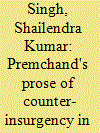|
|
|
Sort Order |
|
|
|
Items / Page
|
|
|
|
|
|
|
| Srl | Item |
| 1 |
ID:
193603


|
|
|
|
|
| Summary/Abstract |
This article examines the durable, yet largely overlooked, claims of Bahu Begam (1727–1815) to dynastic wealth and authority in the Awadh nawabi (1722–1856), a North Indian Mughal ‘successor state’ and an important client of the East India Company. Chief consort (khass mahal) to Nawab Shuja-ud-Daula (r. 1754–75) and mother to his successor Nawab Asaf-ud-Daula (r. 1775–97), Bahu Begam played a well-documented role in the regime’s tumultuous politics, particularly during Warren Hastings’s tenure as the Company’s governor-general (1773–85) and his later parliamentary impeachment. But despite her prominent political influence, little attention has been paid to the substance of her persistent claims to proprietorship over revenue rights and the immense fortune in her custody, as well as her broader assertions of authority over Awadh’s male rulers. Taking those claims seriously, this article contends that the begam rooted her arguments in notions of natural deference to maternal authority and generational seniority, evolving dynastic traditions of co-sharing sovereignty and fiscal resources, and her particular history as a principal financier of the Awadh regime. In so doing, the article argues that the begam’s claims reflect the shifting conceptual language of late-Mughal Persianate political discourse and the ambivalent position of elite women as dynastic financiers and state-builders in early colonial South Asia.
|
|
|
|
|
|
|
|
|
|
|
|
|
|
|
|
| 2 |
ID:
144357


|
|
|
|
|
| Summary/Abstract |
This article suggests that the prose of counter-insurgency, as defined by Ranajit Guha, serves as a theoretical yardstick against which Premchand's discourses about peasants can be measured. This is possible, however, only if Guha's scope is broadened beyond historiography to incorporate fictional as well as journalistic writings. For someone who represents the plight of the peasant with incisive historical accuracy, Premchand's implied corrective for the peasant amounts to a radical departure from the status quo in the United Provinces. In Premchand's non-fictional prose, vis-à-vis the peasant uprisings of Awadh, there are only tangential references or a studied silence; however, his fictional works reveal the rationality of peasants, despite his insistence on compassion, rectitude and integrity. Nevertheless, he never presents peasant discontent as a collective enterprise; the alternatives are provided by the writer's leap of faith, either with the zamindar (landlord) or the sarkar (government). Premchand's literary corpus thus acts as a prose of counter-insurgency that reads peasants' protests as a threat to the social order and an impediment to the nationalist movement for swaraj (self-rule), thereby either relegating it to the peripheral spaces or discarding it altogether.
|
|
|
|
|
|
|
|
|
|
|
|
|
|
|
|
|
|
|
|
|